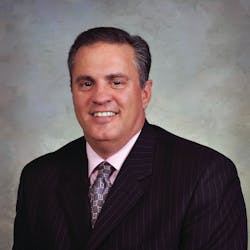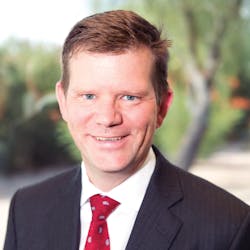In Central Pennsylvania, Geisinger Health System has hired and trained community health assistants, who spend their workdays visiting the homes of patients with congestive heart failure. They bring with them portable high-tech vests called “ReDS” that use radar to detect fluid buildup in the lungs. If a patient reading exceeds established parameters, it gets documented in the EHR (electronic health record) and an RN case manager is notified to determine if further action is required.
Tony Reed, Geisinger’s associate vice president for accountable care initiatives, says efforts such as the ReDS vest program have had a positive impact on Geisinger’s quality scores because, for instance, they have cut down on complications and hospital readmissions. “But more importantly, it also helps us with our patient satisfaction or CAHPS (Consumer Assessment of Healthcare Providers and Systems) scores. Through our community health assistants, case managers and physicians, we are spending more time with patients and engaging them in new and exciting ways. We also think we are scoring higher in our patient satisfaction surveys because we are using these new technologies.”
More work to do on care for complex patients
While they work to improve care coordination and create care management programs for chronic diseases, accountable care organizations (ACOs) also are seeking to engage patients and their families and encourage them to become more involved in decision making about care decisions. In the process, patient surveys suggest they are starting to have a positive impact on consumer perceptions of provider responsiveness, but there is still plenty of work to do to engage patients with complex needs. For instance, there is a fairly new emphasis on addressing social determinants of health.
Kristen Peck, research project director for the Dartmouth Institute for Health Policy and Clinical Practice, led a study of how ACOs are caring for people with complex needs. Survey research of 18 ACOs indicates that they are establishing comprehensive chronic care management processes or programs for people with complex needs, yet few ACOs report having advanced programs for engaging patients, in-home visits after hospital discharge, or evidence-based services for patients needing mental health or addiction treatment.
A report by Peck and colleagues notes that despite being a prominent component of evidence-based care transition models, in-home follow-up is the least commonly used strategy for patients undergoing a care transition. “Only 21 percent of surveyed ACOs with comprehensive care management programs report that most or all patients receive an in-home follow-up visit within 72 hours of discharge, the report noted. “And only 11 percent of the remaining ACOs said that most or all patients receive this in-home visit.”
“Like any organization, ACOs have limited resources and they are focusing strategically on how to use those resources to most benefit patients they are caring for,” says Peck, adding that measuring the impact of new programs is tricky. “Care coordination and the use of evidence-based strategies is multi-dimensional, so when you are dealing with complex patients and approaches that are multi-dimensional, it gets thorny to tease apart individual measurable points about improvement in the care of patients.”
Peck’s colleague, research project coordinator Laura Biedler, notes that ACOs find applying evidence-based strategies challenging. “Most evidence-based strategies were designed and developed at a specific organization and tested there. When you translate those to another ACO, there is a lot of work that needs to be done to tailor it, and that takes a lot of time and resources.”
Emily Brower, senior vice president for clinical integration and physician services at Trinity Health, says that where ACOs can improve the patient experience most is in reducing the fragmentation of care most people tend to experience in fee-for-service settings. Livonia, Mich.-based Trinity Health operates ACO programs with more than 200,000 Medicare beneficiaries and more than 15,000 physicians participating in 18 clinically integrated networks accountable for more than 1.4 million lives. “We are doing that through what we call our integrated care coordination system,” Brower says. “Our goal is to knit care together across settings. We believe that is one of the advantages of being part of an integrated delivery system.”
One of the settings Trinity has focused on is the patient’s home. More than 17,000 patients have used Trinity Health’s Home Care Connect virtual care program, which includes visiting nurses, remote monitoring technology and a 24x7 virtual care center monitored by nurses.
“We also have just recently made a significant commitment to connecting the patient’s record across Trinity Health with one instance of the Epic EHR,” Brower adds. “We believe that will take us significantly further in improving that experience of care through reducing fragmentation and increasing connection.”
Texting across the care continuum
Innovation Care Partners (ICP), a Scottsdale, Ariz.-based clinically integrated network owned by HonorHealth, has nine value-based contracts, including one Medicare Shared Savings Program ACO. To impact the patient experience, it has worked to close the loop between hospital, home and primary care settings, and it has found HIPAA-compliant text messaging critical to its improvement. Through an integration between the internal health information exchange and the texting system, context-rich notifications are sent to transition care managers, primary care physician-based care coordinators and primary-care providers on a 24/7 basis.
“We have transitional case managers in the acute-care setting, who let the patient know they will be helping them as they leave the hospital and get services set up around them at home,” explains Karen Vanaskie, R.N., chief clinical officer. ICP uses texting to communicate with the care coordinator in the primary-care office and get an appointment scheduled. “Our care coordinators are trained to go into the home if necessary to see what services are needed and what is available,” Vanaskie adds. “Our team also follows patients in skilled nursing facilities and rehab centers. In the post-acute setting we require their intake coordinators and case managers to be on that HIPAA-compliant texting system, so we can all talk together. It is a safer way to manage that patient. We don’t let go of that patient throughout the continuum.”
ICP care coordinators conduct three assessments with its patients once they leave the hospital: a depression screening, a quality-of-life screening, and a patient engagement assessment, using a patient activation measure tool. “We will repeat those three assessments after the care coordinator has been working with the patient four to six months,” says James Whitfill, M.D., chief transformation officer at HonorHealth, “and we have seen definite increases in engagement and lower scores on the depression scale.”
‘Wrapping arms around patients’
Dr. Whitfill has noted that a big part of ICP’s success is tied to it being physician-led, and the same can be said for the ACOs that Bethesda, Md.-based Aledade Inc. has helped set up with physician groups across the country.
“Part of the success within our ACOs has to do with enabling our providers to get a full sense of their patients,” says Paul Kleeberg, M.D., a medical director at Aledade. From the patient perspective, I think that feels like someone is wrapping their arms around you and taking care of you.” The company says it has seen a continual decline in unnecessary emergency department visits and readmissions across its ACOs.
A big ingredient in the Aledade special sauce is a homegrown population health software platform that providers and practice transformation specialists use during “huddles” in the morning before seeing patients. “When they open the app, they see an interface to their scheduling system,” Kleeberg explains. “We provide them with a list of patients they are going to see today, a list of diagnoses they may not have been aware of and a list of preventive services to be offered. The huddle also allows them to see what the patient’s risks currently are and what specialists and hospitals they have been to. That helps the patient feels like the doctor knows them during a wellness visit. That personal touch encourages patients to feel like they have a place that can help them meet their needs.”
Like other groups, Aledade’s ACOs also stress transitional care management. “A number of years ago it was very common that a patient would go to the hospital and then show up at my primary care office, and I would have no idea what they had been in the hospital for,” Kleeberg says. “We have tried to connect all our patients’ hospitals through an ADT (admission, discharge and transfer) system so primary care doctors are aware when patients are discharged. They can make sure the patient understands their medications and schedule a visit to make sure things are going well. That improves patient health, lets them know we care, and has an impact on readmission rates.”
In helping practices move from fee-for-service to population management, Kleeberg says it is not something a provider can do alone in an exam room. It requires an entire team to work on it. “In smaller practices, we use staff that is already there for roles such as chronic care management, but in larger practices adding staff members to handle care management can be cost-effective.”
Getting to patient activation
Joann Sciandra, R.N., Geisinger’s vice president of care coordination and integration, oversees social workers, community health assistants, and case managers embedded in primary care. She says the ReDS vest program is just one of its approaches to working with heart failure patients. They have between 600 and 700 at-risk members using Bluetooth scales with integrated voice response technology pre-programmed with a list of questions designed to detect changes that may require follow-up with a case manager or provider such as shortness of breath, swelling or appetite changes. “As we get to know them, we are able to fine-tune it and tailor the technology to meet the individual needs of patients,” she says.
Sciandra says the case management approach combined with technology is appreciated by patients. “We have patients say, ‘I can’t believe my health plan and my doctor care enough to be this connected to me.’”
Geisinger’s Tony Reed says that even beyond patient surveys, the quality measures in CMS’ ACO programs do a good job of getting at some patient experience issues. “For the last several years we have had quality measures that track how well we were managing COPD and heart failure patients and how often they were readmitted. We tried to bring to bear these tools to bring those numbers down and increase our quality scores, and we believe we are heading in the right direction doing that,” he notes. But Geisinger also is seeing improvements in patient activation, he adds.
Reed shares a story from Geisinger Chief Medical Officer Rick Martin, a primary-care physician. “One of his patients was a ReDS vest patient. He came in for a visit telling Dr. Martin what his ReDS vest values were. He can correlate those numbers to how he is feeling. His patient was perceptive enough to understand what the vest’s values mean and how he feels when the values are 34 vs. 35 and recite them to his doctor just like his blood pressure number. I think that is amazing.”





